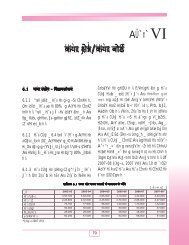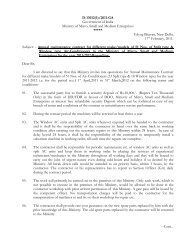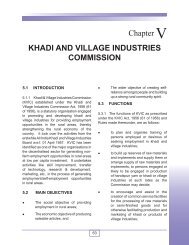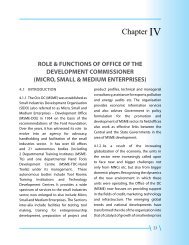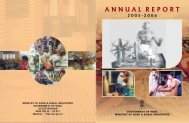Evaluation Study MSE Cluster Development - Ministry of Micro ...
Evaluation Study MSE Cluster Development - Ministry of Micro ...
Evaluation Study MSE Cluster Development - Ministry of Micro ...
You also want an ePaper? Increase the reach of your titles
YUMPU automatically turns print PDFs into web optimized ePapers that Google loves.
Chapter No:2 – The General Pr<strong>of</strong>ile <strong>of</strong> Sampled <strong>Cluster</strong>sCHAPTER2THE GENERAL PROFILE OFSAMPLED CLUSTERS2.1 IntroductionThe clusters we have selected for the study have been broadly classified into two groups.The first group <strong>of</strong> clusters which are the Primary Goods Based <strong>Cluster</strong>s (PGBC), mostlyinvolve the processing and value addition to primary goods produced in the agricultureand animal husbandry sector. These clusters are seen to add value to primary productssuch as food grain, fruits and vegetables, Bamboo and Wood, Rubber, and Leather.These agro-based activities are largely taken up as cottage or artisanal occupations thatsupplement meager agricultural incomes and are based on easily available inputs, andlocal skills, catering to the needs <strong>of</strong> local markets and peri-urban demand. They areusually based on labour intensive production methods and are dependent on surpluslabour. Their working capital requirements are confined to simple tools and traditionaltechnologies. Since members <strong>of</strong> the household normally take them up, these activitiesare widely dispersed over village habitations covering a large geographical area,sometimes an entire block or even a small district.However it needs to be clarified that there are some exceptions among these PGBCswhich use fairly advanced processing technologies and industrial inputs, though theirmajor raw material is drawn from the primary sector. The Plywood and Rubber GoodsManufacturing <strong>Cluster</strong>s in this group stand out as exceptions since they involve relativelyhigher levels <strong>of</strong> processing, technology and the use <strong>of</strong> skilled industrial labour. RiceMilling has also to a very large extent evolved from being a traditional household basedactivity to a large scale, highly mechanized industrial process using modern machineryand power. Their scale <strong>of</strong> operation is quite large and similar to any normalmanufacturing activity.Over time these activities tend to get concentrated and localized among the betterequipped and skilled artisan groups who are able to cater to the demand for goods thatare standardized and <strong>of</strong> higher quality. This gradual process leads to the formation <strong>of</strong>identifiable clusters. In spite <strong>of</strong> being relatively dispersed over a large geographicalarea, they provide opportunity to harness the collective energies and externalities <strong>of</strong>cooperation.The Secondary Goods Based <strong>Cluster</strong>s (SGBC) unlike the first group are more localizedand relatively less dispersed as they are <strong>of</strong>ten located in traditionally well definedindustrial areas and estates where essential infrastructure likepower and water supply is available and accessible. They are dependent on both skilledand unskilled labour, utilizing tools plant and machinery that embody a fairlysophisticated level <strong>of</strong> technology and technical inputs.Unlike their agro-based counterparts, they require relatively higher investments andneed larger doses <strong>of</strong> working capital.27





